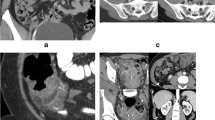Abstract
Right lower quadrant pain in children can result from various underlying conditions other than acute appendicitis. The common mimics of acute appendicitis are related to acute gastrointestinal and genitourinary diseases. Diagnosis of right lower quadrant pain in the pediatric population can be challenging, especially when the symptoms are often nonspecific. This article reviews the currently available imaging techniques for evaluating a child with right lower quadrant pain and the spectrum of differential diagnoses with a focus on imaging clues to a specific diagnosis.























Similar content being viewed by others
References
Manson D (2004) Contemporary imaging of the child with abdominal pain or distress. Paediatr Child Health 9(2):93–97
Rothrock SG, Green SM, Harding M, et al. (1991) Plain abdominal radiography in the detection of acute medical and surgical disease in children: a retrospective analysis. Pediatr Emerg Care 7(5):281–285
Mazzei MA, Guerrini S, Cioffi Squitieri N, et al. (2013) The role of US examination in the management of acute abdomen. Crit Ultrasound J 5(Suppl 1):S6. doi:10.1186/2036-7902-5-S1-S6
Strauss KJ, Goske MJ, Kaste SC, et al. (2010) Image gently: ten steps you can take to optimize image quality and lower CT dose for pediatric patients. AJR Am J Roentgenol 194(4):868–873. doi:10.2214/AJR.09.4091
Chavhan GB, Babyn PS, Singh M, Vidarsson L, Shroff M (2009) MR imaging at 3.0 T in children: technical differences, safety issues, and initial experience. Radiographics 29(5):1451–1466 (Review). doi:10.1148/rg.295095041
Chang KJ, Kamel IR, Macura KJ, Bluemke DA (2008) 3.0-T MR imaging of the abdomen: comparison with 1.5 T. Radiographics 28(7):1983–1998 (Review). doi:10.1148/rg.287075154
Anupindi S, Jaramillo D (2002) Pediatric magnetic resonance imaging techniques. Magn Reson Imaging Clin N Am 10(2):189–207
Pruessmann KP (2004) Parallel imaging at high field strength: synergies and joint potential. Top Magn Reson Imaging 15(4):237–244
Slovis TL (2011) Sedation and anesthesia issues in pediatric imaging. Pediatr Radiol 41(Suppl 2):514–516. doi:10.1007/s00247-011-2115-2
Cravero JP, Blike GT (2004) Pediatric sedation. Curr Opin Anaesthesiol 17(3):247–251
Rappaport B, Mellon RD, Simone A, Woodcock J (2011) Defining safe use of anesthesia in children. N Engl J Med 364(15):1387–1390. doi:10.1056/NEJMp1102155
Haliloglu M, Hoffer FA, Gronemeyer SA, Rao BN (1999) Applications of 3D contrast-enhanced MR angiograpy in pediatric oncology. Pediatr Radiol 29(11):863–868. doi:10.1007/s002470050714
Puligandla PS, Nguyen LT, St-Vil D, et al. (2003) Gastrointestinal duplications. J Pediatr Surg 38(5):740–744. doi:10.1016/jpsu.2003.50197
Blank G, Konigsrainer A, Sipos B, Ladurner R (2012) Adenocarcinoma arising in a cystic duplication of the small bowel: case report and review of literature. World J Surg Oncol 10:55. doi:10.1186/1477-7819-10-55
Orr MM, Edwards AJ (1975) Neoplastic change in duplications of the alimentary tract. Br J Surg 62(4):269–274
Levy AD, Hobbs CM (2004) From the archives of the AFIP. Meckel diverticulum: radiologic features with pathologic correlation. Radiographics 24(2):565–587 (Review). doi:10.1148/rg.242035187
Bani-Hani KE, Shatnawi NJ (2004) Meckel’s diverticulum: comparison of incidental and symptomatic cases. World J Surg 28(9):917–920
Ashley RA, Inman BA, Routh JC, et al. (2007) Urachal anomalies: a longitudinal study of urachal remnants in children and adults. J Urol 178(4 Pt 2):1615–1618. doi:10.1016/j.juro.2007.03.194
Navarro O, Daneman A (2004) Intussusception. Part 3: diagnosis and management of those with an identifiable or predisposing cause and those that reduce spontaneously. Pediatr Radiol 34(4):305–312 (quiz 369). doi:10.1007/s00247-003-1028-0
Ein SH (1976) Leading points in childhood intussusception. J Pediatr Surg 11(2):209–211
Pritt BS, Clark CG (2008) Amebiasis. Mayo Clin Proc 83(10):1154–1159 (quiz 1159–1160). doi:10.4065/83.10.1154
Wilhelmi I, Roman E, Sanchez-Fauquier A (2003) Viruses causing gastroenteritis. Clin Microbiol Infect 9(4):247–262 (Review)
Sauer CG, Kugathasan S (2009) Pediatric inflammatory bowel disease: highlighting pediatric differences in IBD. Gastroenterol Clin North Am 38(4):611–628. doi:10.1016/j.gtc.2009.07.010
Grattan-Smith JD, Blews DE, Brand T (2002) Omental infarction in pediatric patients: sonographic and CT findings. AJR Am J Roentgenol 178(6):1537–1539. doi:10.2214/ajr.178.6.1781537
Ting TV, Hashkes PJ (2004) Update on childhood vasculitides. Curr Opin Rheumatol 16(5):560–565
Karlo CA, Gnannt R, Winklehner A, et al. (2013) Split-bolus dual-energy CT urography: protocol optimization and diagnostic performance for the detection of urinary stones. Abdom Imaging 38(5):1136–1143. doi:10.1007/s00261-013-9992-9
Ascenti G, Siragusa C, Racchiusa S, et al. (2010) Stone-targeted dual-energy CT: a new diagnostic approach to urinary calculosis. AJR Am J Roentgenol 195(4):953–958. doi:10.2214/AJR.09.3635
Kinkel K, Chapron C, Balleyguier C, et al. (1999) Magnetic resonance imaging characteristics of deep endometriosis. Hum Reprod 14(4):1080–1086
Author information
Authors and Affiliations
Corresponding author
Rights and permissions
About this article
Cite this article
Chang, P.T., Schooler, G.R. & Lee, E.Y. Diagnostic errors of right lower quadrant pain in children: beyond appendicitis. Abdom Imaging 40, 2071–2090 (2015). https://doi.org/10.1007/s00261-015-0482-0
Published:
Issue Date:
DOI: https://doi.org/10.1007/s00261-015-0482-0




